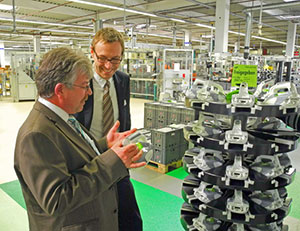Most of my shirts never see the heat of an iron, but I do have one for funerals and weddings and I know that better groomed people use them all of the time, so I know how important they can be. Rowenta’s new line of iron models is a testament to how seriously people take their creases. Though their latest irons were ultimately made via injection moulding, the moulds themselves had to be so intricate that, to forge them, Rowenta had to use a powerful process.

In order to mass-produce intricate, plastic parts that wouldn’t warp, Rowenta needed to rely on conformal cooling[1]. By creating a series of cooling channels in their moulds that closely mirrored their desired design, Rowenta could create more elaborate parts en masse. But, in order to make such a complex mould in the first place, with specific cooling channels, they would turn to Hofmann Innovation Group a company that utilizes the metal 3D printing process, LaserCUSING, from Concept Laser.

LaserCUSING is a powder-based process, and uses a laser to zap the said powder, similar to DMLS and SLM but, according to the LaserCUSING site, “LaserCusing[2], puts many times the energy used in these other processes into the powder-bed. This completely melts the metal materials, including steel, so that fully-dense parts and components are directly formed.” The LaserCUSING people argue that this process yields parts that have a higher internal strength and fewer pores than parts made from other additive metal processes.
The partnership between Hofmann and Rowenta illustrates that, while 3D printing may not be obvious in the end stages of product development, it is used behind the curtains to aid traditional manufacturing processes. And, in the case of Rowenta’s irons, additive and traditional manufacturing joined together to make the mass production of more complex parts possible.
In case you’re new to LaserCUSING, here’s a video demonstrating the process:
[1] For a neat visual explanation of how conformal cooling works, watch this video.
[2] I’ve seen LaserCusing spelled with the angry caps and without, but don’t let it confuse you: it’s all LaserCUSING, baby.


